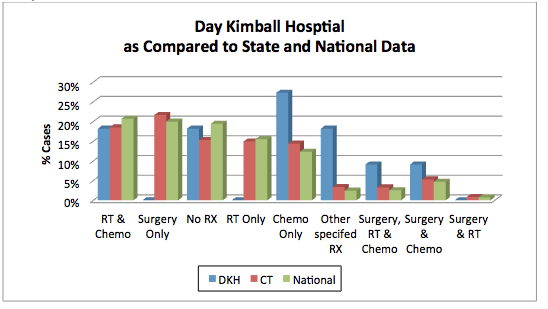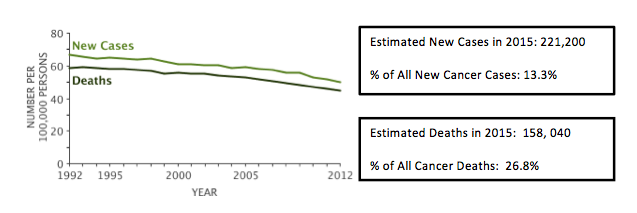Public Reporting of Outcomes: Non-Small Cell Lung Cancer
The Day Kimball Hospital Experience
Lung cancer is the second most common cancer in both men and women. In 2015, about 221,200 new cases of lung cancer are expected, according to the American Cancer Society. Approximately 2 of 3 people diagnosed with lung cancer are 65 or older. The average age of diagnosis is about 70 years of age.
Lung cancers are broadly divided into 2 types: Non-small cell lung cancer (NSCLC) and Small cell Lung Cancer. The former is much more common than the latter, accounting for about 85% of all lung cancers. This overview of lung cancer diagnostics, care and treatment at Day Kimball Hospital will focus on Non-small cell lung cancer.
It is estimated that over 85% of lung cancers are caused by cigarette smoking or from second-hand smoke. Some other risk factors include radon exposure, asbestos exposure, cancer-causing agents in the workplace and air-pollution.
Screening and Prevention
The NCCN guidelines recommend low-dose CT (LDCT) screening in high risk smokers and former smoker with a 30-year smoking be evaluated with LDCT. This strategy can help improve survival by detecting smaller, earlier-stage and more treatable cancers than can be detected by a chest X-ray.
Since 2014 DKH has been offering low-dose CT lung screening.
Here we share our DKH experience with NSCLC by reviewing our data and comparing it to the state and national data.
Timeframe: Year of First Contact 2014
State and National data are from National Cancer Database; year of first contact 2013. This is the most current comparative data available
Number of Cases of NSCLC at DKH: 11
Comparison - Gender: 
Comparison - Age at DX: 
Comparison - Stage at Diagnosis:
Treatment
Surgery is the best treatment option for early stage NSCLC and may include open thoracotomy or these days most often video assisted thoracoscopic surgery (VATS), which uses several small incisions which allows for faster recovery.
Radiation therapy uses high-energy radiation to kill cancer cells and to shrink tumors. Radiation therapy can be used to treat early stage disease with curative intent and to palliate certain symptoms such as pain in patients with early or advanced stage disease.
Chemotherapy is the use of anticancer drugs to kill cancer cells. The oncologist plans a treatment regimen for each individual. Chemotherapy may be combined with other modalities of treatment for curative approach or by itself for shrinking the cancers and improving the symptoms in advanced stage disease.
Targeted therapy uses drugs that target specific parts of cancer cells or nearby cells that help them grow. For example, as cancers grow, they form new blood vessels which nourish them. Bevacizumab by blocking the growth of these blood vessels is helpful in treatment of certain types of NSCLC. Some other agents against specific targets include Crizotinib, Erlotinib, and Cetuximab.
Treatment by Stage – Day Kimball Hospital
Comparison – First Course Treatment
Survival
Surveillance Epidemiology End Results (SEER) Facts and Figures: 
Conclusions:
Lung cancer is a devastating illness brought about in a large part by lifestyle choices. Yet if diagnosed at an early stage, there is a high chance of a cure. With a caveat that our numbers are small and hence one cannot draw any statistical conclusions, it appears that our patients present with more advanced form of Non-small cell lung cancer where a curative outcome is not possible. However this data indicates that there may be an opportunity to implement strategies for prevention such as smoking cessation and efforts for earlier diagnosis by community education and screening efforts such as Low dose CT scanning.
References:
American Cancer Society Web-site: http://www.cancer.org/cancer/lungcancer-non-smallcell
NCCN Web-site: http://www.nccn.org/professionals/physician_gls/f_guidelines.asp
SEER Web-site: http://seer.cancer.gov/statfacts/html/lungb.html

